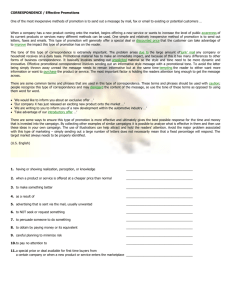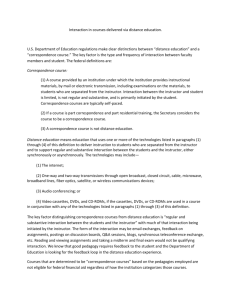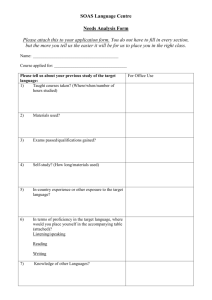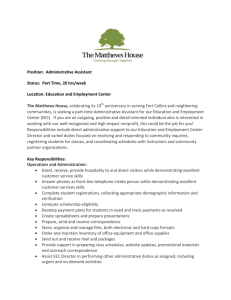Biz Correspondence Assignments
advertisement
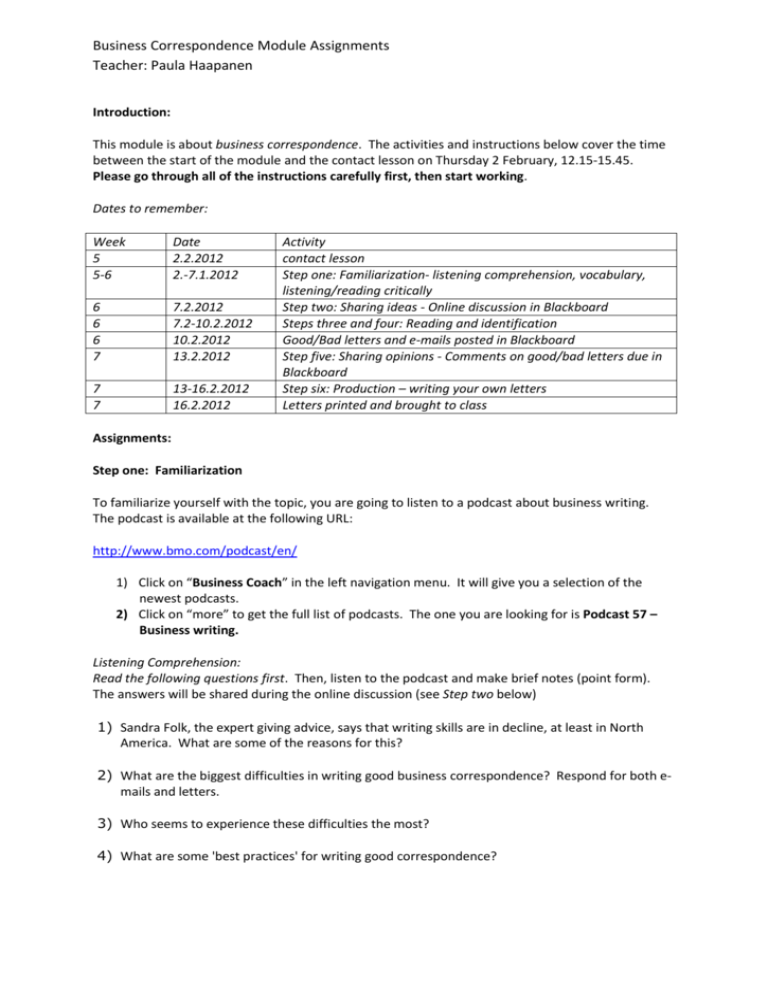
Business Correspondence Module Assignments Teacher: Paula Haapanen Introduction: This module is about business correspondence. The activities and instructions below cover the time between the start of the module and the contact lesson on Thursday 2 February, 12.15-15.45. Please go through all of the instructions carefully first, then start working. Dates to remember: Week 5 5-6 Date 2.2.2012 2.-7.1.2012 6 6 6 7 7.2.2012 7.2-10.2.2012 10.2.2012 13.2.2012 7 7 13-16.2.2012 16.2.2012 Activity contact lesson Step one: Familiarization- listening comprehension, vocabulary, listening/reading critically Step two: Sharing ideas - Online discussion in Blackboard Steps three and four: Reading and identification Good/Bad letters and e-mails posted in Blackboard Step five: Sharing opinions - Comments on good/bad letters due in Blackboard Step six: Production – writing your own letters Letters printed and brought to class Assignments: Step one: Familiarization To familiarize yourself with the topic, you are going to listen to a podcast about business writing. The podcast is available at the following URL: http://www.bmo.com/podcast/en/ 1) Click on “Business Coach” in the left navigation menu. It will give you a selection of the newest podcasts. 2) Click on “more” to get the full list of podcasts. The one you are looking for is Podcast 57 – Business writing. Listening Comprehension: Read the following questions first. Then, listen to the podcast and make brief notes (point form). The answers will be shared during the online discussion (see Step two below) 1) Sandra Folk, the expert giving advice, says that writing skills are in decline, at least in North America. What are some of the reasons for this? 2) What are the biggest difficulties in writing good business correspondence? Respond for both emails and letters. 3) Who seems to experience these difficulties the most? 4) What are some 'best practices' for writing good correspondence? Business Correspondence Module Assignments Teacher: Paula Haapanen Vocabulary: Please look at the “Transcript.doc” file available in Noppa under ‘LecturesBusiness Correspondence Module’. This is a transcript of the podcast you have just listened to. You will notice that the lines are numbered and that certain words are highlighted in bold text and in italics. What do the words/phrases in bold in the list below mean? You have been given the line on which they can be found in the transcript and also a bit of text in some cases to put the context into perspective. 1) First try to guess their meaning from the context (i.e., check the transcript). Write down what you think it means. 2) Then look up the word in a monolingual English dictionary. Merriam-Webster’s Online Dictionary is a good place to start at www.m-w.com or www.yourdictionary.com . Was your initial guess correct? If not, write down the dictionary definition next to your original guess. 3) If you are still not clear on the meaning, check a bilingual dictionary. Remember context! The first entry in a bilingual dictionary may not be the right one. Line 2: tackles the top issues 7: writing skills are in decline, 8: reduced productivity 8: lost opportunities for business which no one can afford in a recession 22: do not attain a minimum level of literacy 24: championing literacy in Canada 41: foremost way of communicating in business communication today. 46: there is a lot of jargon, 46: are related to people not writing concisely 68: the front line all the way up to the corner office? 81: it’s ubiquitous, 85: how can this problem be remedied? 91: improve people’s remedial writing. 94: impact on retention Business Correspondence Module Assignments Teacher: Paula Haapanen Listening/reading critically: Listen to the podcast again. At 4:20-4:33 in the recording (line 58 of the transcript), Sandra Folk describes a conversation she had with a student, “…’I am an English major and I was taught that I should be wordy and expand my ideas’. However, she realizes now that this type of writing does not work for business and where you need to be more focused on shorter sentences, the active voice, precise and using action-oriented verbs to get your point across. “ What type of writing do you think that Sandra Folk is talking about? Write down your answer and bring it with you to the contact session. We will be using these answers in discussion. Step two: Sharing ideas Online discussion Date: Tuesday 7 February 2012 Think about the following questions. Prepare your answers based on your own knowledge or do a bit of research to find specific examples. Please make brief notes. You will be discussing these together, online on Tuesday 7 February. 1. This podcast was produced in Canada. What kind of a situation exists in your home country regarding writing? Is it good or bad? Why? 2. What characteristics do you think describe ‘good’ and ‘bad’ correspondence? 3. What is correspondence like in your home country? What kinds of things need to be considered when writing business correspondence? Think about: a. how writers address the reader , b. how quickly they get to the point of why they’re writing, c. what kind of language is used (is there a difference between formal/informal language for example), d. how much/little explanation is given, etc. Instructions for online discussion: The discussion will take place in Blackboard throughout the day on Tuesday 7 February. The forum will be open earlier but the official discussion will take place on Tuesday 7 February. Each of the questions will have its own forum space. You are required to: 1. write a response to each of the questions in English. 2. write a comment on someone else’s response in English. 3. answer questions in English asked of you in the forum. One comment/response is the minimum in each of the forum spaces but you are welcome to, and indeed encouraged to, spar and discuss things in further detail. Business Correspondence Module Assignments Teacher: Paula Haapanen There is, of course, some basic netiquette that needs to be followed: We’ll be talking about opinions and because opinions are personal, responses might be taken personally if written carelessly. Remember, let the facts argue but don’t attack the person. Good starting phrases into controversial topics are: o While I see your point, I feel that… o Unfortunately, I don’t agree with that stance (notice how the phrase uses ‘that’ stance instead of ‘your’ stance). The responses to the teacher’s questions should be posted by 12.00 on Tuesday 7 February and the commenting can begin after that. The teacher will be actively going into the forum to check if students have been posting. The teacher will also take part in the discussion. Commenting will be continued until midnight, after which comments will no longer be accepted. Step three: Going deeper reading Read the text titled ‘Correspondence – What you should know’. This is available in Noppa under ‘LecturesBusiness Correspondence Module’. It gives you some more insight into the differences between formal correspondence, informal correspondence and less formal correspondence. Step four: Identification Now that you have listened to, read about and discussed some good and bad characteristics of business correspondence, go online and find: 1. one example of a good e-mail or letter in English, 2. one example of a bad e-mail or letter in English. These should be posted in Blackboard, in the forum “good and bad correspondence samples” by Friday 10 February 2012. Please include a brief explanation (100 words or less) of what was good in the text and what you thought was not so good. Some hints for looking: University writing centre and government websites are usually reliable. Job search websites (like Monster) have some good examples. About.com has some interesting choices. Instructions for posting: Please, only include one text per post. The subject of the post should be: Your name – good e-mail/letter OR your name – bad email/letter. Cut and paste the whole text into your message (including addresses and dates if there are any). Make sure that you correct any formatting that may not have copied from the original. Make sure you include the URL where you took the text from. This can come right after the text. Business Correspondence Module Assignments Teacher: Paula Haapanen Underneath the text and the URL, please include a brief explanation of what was good in the text and what you thought was not so good. Step five: Sharing opinions Once everyone has uploaded a good/bad example into Blackboard, choose ONE ‘good’ example and ONE ‘bad’ example to respond to (they don’t have to be from the same person). Things to consider when responding (you can add to this list of course): Do you share the same opinion with the person who posted? Is the letter good/bad? If not, describe how you see the letter according to your list of characteristics. If you do share the same opinion, did you find other examples of good/bad characteristics that the other person may have missed? Comments/responses should be posted on Monday 13 February 2012 by 12.00. The forum will be closed after that. Step six: Production Now it is your turn to write a letter. Pick one of the following scenarios: 1. Request: You need price information about a product (you decide what the product is) and the information is not available on the company’s website. Write a letter/e-mail requesting the information. 2. Good news/Bad news: You have just received 2 letters from different employers offering you traineeships. One employer is a major multinational company whose head office is in Australia. You know that this company has a lot of potential for future employment and upward mobility but the traineeship is only for 3 months and the salary is not very good. The other employer is a smaller, family-run organization closer to home. They too have a lot of contacts but not in the field that you are in. On the other hand, the trainee salary is quite good and they've offered you a 6-month traineeship. Write a letter of acceptance (good news) to the company that you want to work for and a letter of rejection (bad news) to the company that you do not want to work for. 3. Problem/solution: You are the Human Resource manager of a company. One team feels overworked because of a lack of resources and underappreciated. Write a letter/e-mail to the board, explaining the situation and proposing a solution. 4. Complaint: A contractor you have been working with constantly misses deadlines. You have been in contact with the contractor about this matter via phone and e-mail on numerous occasions in the last year. Write a formal letter of complaint to the contractor, indicating specifically what you are complaining about and what you will do if things are not corrected. Business Correspondence Module Assignments Teacher: Paula Haapanen 5. Adjustment: Write a reply to the scenario in #4. Decide whether or not you will apologize for the delays or not. Business Correspondence Module Assignments Teacher: Paula Haapanen Print out your letter(s) and bring it(them) with you to class on Thursday 16 February 2012. We will be using them for peer feedback and then the teacher will collect them, mark them and return them at a later date. To help you on your way, go to the following websites: Request letter: http://www2.elc.polyu.edu.hk/CILL/eiw/enquiry_letter_constructor.htm http://www.chs.riverview.wednet.edu/Staff/Hall/business_letter_format/business_letters.htm Good/Bad news letter: http://www.chs.riverview.wednet.edu/Staff/Hall/business_letter_format/business_letters.htm Complaint letter: http://www2.elc.polyu.edu.hk/CILL/eiw/complaint_letter_constructor.htm Adjustment letters: http://www2.elc.polyu.edu.hk/CILL/eiw/adjustmentletters.htm



